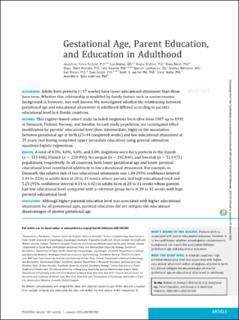| dc.description.abstract | BACKGROUND: Adults born preterm (<37 weeks) have lower educational attainment than those born term. Whether this relationship is modified by family factors such as socioeconomic background is, however, less well known. We investigated whether the relationship between gestational age and educational attainment in adulthood differed according to parents’ educational level in 4 Nordic countries. METHODS: This register-based cohort study included singletons born alive from 1987 up to 1992 in Denmark, Finland, Norway, and Sweden. In each study population, we investigated effect modification by parents’ educational level (low, intermediate, high) on the association between gestational age at birth (25–44 completed weeks) and low educational attainment at 25 years (not having completed upper secondary education) using general estimation equations logistic regressions. RESULTS: A total of 4.3%, 4.0%, 4.8%, and 5.0% singletons were born preterm in the Danish (n = 331 448), Finnish (n = 220 095), Norwegian (n = 292 840), and Swedish (n = 513 975) populations, respectively. In all countries, both lower gestational age and lower parental educational level contributed additively to low educational attainment. For example, in Denmark, the relative risk of low educational attainment was 1.84 (95% confidence interval 1.44 to 2.26) in adults born at 28 to 31 weeks whose parents had high educational level and 5.25 (95% confidence interval 4.53 to 6.02) in adults born at 28 to 31 weeks whose parents had low educational level, compared with a reference group born at 39 to 41 weeks with high parental educational level. CONCLUSIONS: Although higher parental education level was associated with higher educational attainment for all gestational ages, parental education did not mitigate the educational disadvantages of shorter gestational age. | en_US |

